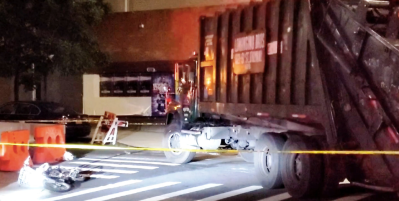Life-Saving Truck Design Fix Sidelined By Federal Inaction
This is the second post in a series about safety features for large vehicles. Part one examined the case for truck side guards and New York City’s attempt to require them for its fleet.

American cities are beginning to take the lead on requiring side guards on large trucks in municipal fleets. That’s a good first step toward saving lives, but without addressing privately-owned vehicles, city streets will not be safe from trucks that tend to crush people beneath the rear wheels after impact. The federal government continues to drag its feet, however, and without a national mandate, the prospects for meaningful action from Albany look slim.
Last year, the National Transportation Safety Board recommended installing side guards on all large trucks, but the National Highway Traffic Safety Administration, which regulates truck design, has yet to pass a rule requiring them. NHTSA says it might begin soliciting input on new trailer guard rules by the middle of next year. Traditionally, the agency has focused on guards for the back end of trucks, which protect car occupants in rear-end collisions. There’s no guarantee that any progress toward new rules next year will include side guards.
In the absence of federal rules requiring side guards for trucks, state and local legislators have taken tentative steps toward addressing the problem. Albany’s previous attempts at similar legislation don’t inspire confidence, however. A recently enacted state law mandates “crossover” mirrors to reduce the size of blind spots in front of trucks weighing at least 26,000 pounds that operate on New York City streets. Enforcement of the mirror law is dismal, in part because of a loophole that exempts trucks registered out-of-state. The ultimate fix would be a national crossover mirror mandate, but the federal government has not shown any inclination to take that up.
A state or local side guard mandate could fall into a similar enforcement black hole. In April, the City Council held a hearing on a bill that would require side guards on all trucks making deliveries in the city. “There are some issues about when you try and mandate a certain technology within the city, there can be issues with state and federal law,” NYC DOT Commissioner Polly Trottenberg said, according to minutes of the hearing. “We think this is important but we want to make sure we get it right.” The legislation has since been put on hold.
Meanwhile, in Albany, two proposals this year targeted trucks on city streets weighing at least 26,000 pounds but would have exempted vehicles registered out-of-state. One of the bills was introduced in both Senate and Assembly committees earlier this year, but never came up for a vote. (Senator Brad Hoylman says he plans to re-introduce the legislation next session.)
A different bill from Senator Rubén Díaz, Sr., named in honor of Amar Diarrassouba, a 7-year-old boy killed by a turning truck driver while walking to school in East Harlem last year, seemed poised to make progress. Díaz’s bill received a vote in the Senate transportation committee in March. It was voted down, 9-10, when senators cited concern that side guards would cost too much for truck companies to install.
In the third and final installment in this series, we’ll look at why rear wheel guards to prevent people from getting crushed beneath buses are not being used in New York City.
